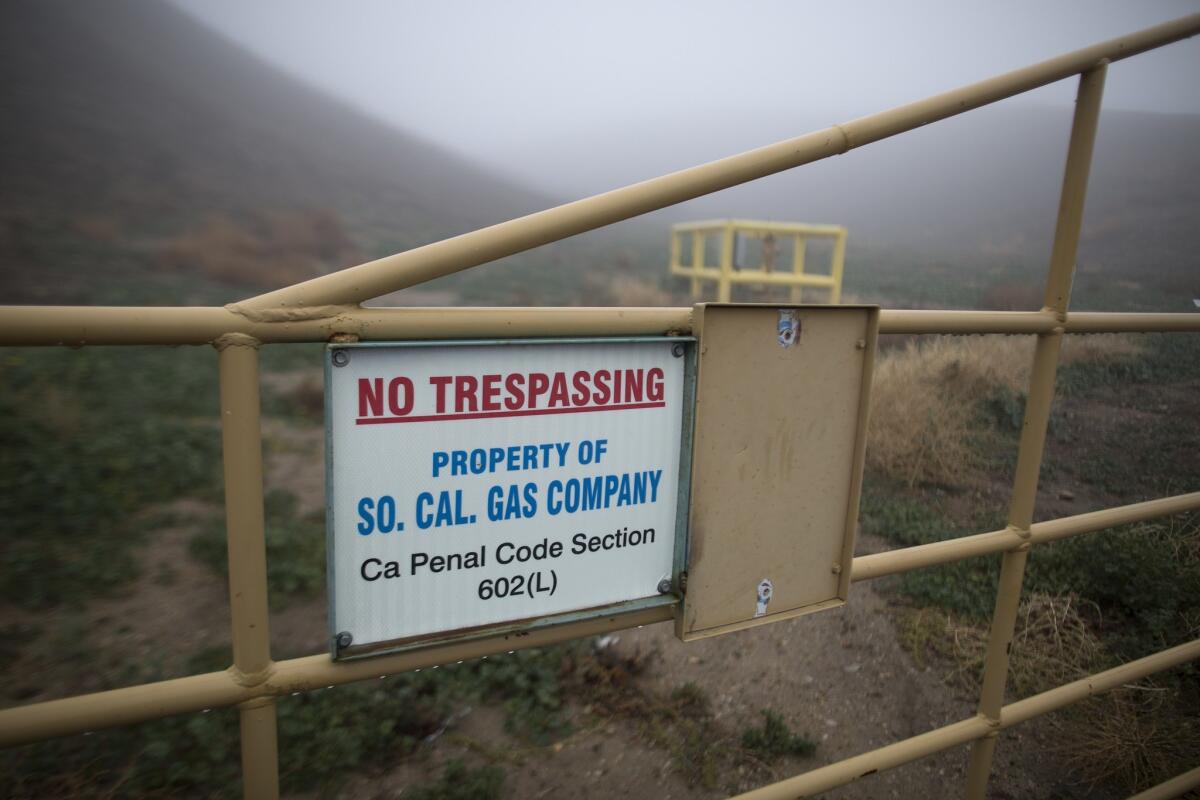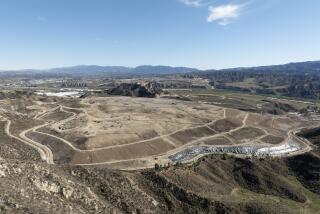Commission probing permanent closure of Aliso Canyon gas field amid massive leak

The California Public Utilities Commission wants to know if Southern California Gas Co. can find alternative storage sites and delivery systems should the Aliso Canyon natural gas field near Porter Ranch be taken offline in the future.
- Share via
The California Public Utilities Commission is studying the effects of permanently shutting down the Aliso Canyon natural gas field near Porter Ranch, an indication the agency is uncertain about the future integrity of the storage system that supplies 11 million customers in Southern California.
The commission wants to know whether Southern California Gas Co. can find alternative storage sites and delivery systems to make up for a possible shortfall of gas should the 3,600-acre field be taken off-line in the future.
Edward Randolph, energy division director at the PUC, said the regulatory agency is studying the issue for several reasons, “including that, with several investigations underway, policymakers in California want to know all possible short- and long-term options.”
“Until there are definitive answers on the future of Aliso Canyon, we want to do everything we can to assure reliability knowing that Aliso Canyon is not going to be able to provide the levels of service it historically has,” Randolph said.
A week ago, Timothy Sullivan, executive director of the PUC, ordered the utility to work with government agencies to develop alternatives to reliance on Aliso Canyon.
Gas company spokeswoman Stephanie Donovan declined to comment on the issue, except to say, “We’re not going to try to speak for the CPUC.”
Sustaining energy reliability without the 3,600-acre facility would be daunting. Existing pipelines lack the capacity to make up such a shortfall, according to the Governor’s Office of Emergency Services, and other storage facilities in the region are too small or too far away to provide gas quickly enough when needed.
Disruption of gas service requires technicians to visit homes and businesses to relight pilot lights on furnaces and water heaters — a process that could take weeks if the interruption is widespread. Curtailing gas for electric power generation could trigger blackouts during peak demand periods in summer.
Commission safety officials say their top priorities are stopping the leak that has displaced thousands of residents since it began spewing mostly methane Oct. 23 and ensuring that it never happens again.
“We hear loud and clear that many members of the local community want Aliso Canyon permanently taken out of service,” Elizaveta Malashenko, director of safety and enforcement at the PUC, said in a report to her agency Jan. 21.
“First, we are working on analysis of how reliability issues can be addressed now and if Aliso Canyon is not operational during the upcoming summer,” Malashenko said. “Second, we are working on the analysis of how reliability issues can be addressed if Aliso Canyon is not operational next winter and beyond.”
Rep. Brad Sherman, a resident of Porter Ranch, said he does not believe the gas company has enough storage elsewhere to guarantee delivery to power generation plants during peak demands in the summer.
“If it is feasible, it ought to be shut down — but I’m not holding my breath,” Sherman said. “That’s because they’ve created a facility that is literally too big to fail.”
The gas company operates four underground storage fields in Southern California with a combined “working gas” capacity of about 136 billion cubic feet. Aliso Canyon is by far the largest, with a working gas capacity of 86.2 billion cubic feet.
The leak rate of the ruptured well has dropped by two-thirds to 18,400 kilograms per hour since its peak Nov. 28. The decline was achieved by increasing withdrawals of gas from the storage reservoir, which reduced the pressure that is pushing the gas up the well and leaking out, the gas company said. As a result, the reservoir has gone from being 90% full before the leak to at most 37% full Jan. 10.
The PUC has been working with state agencies including the California Energy Commission and California Independent System Operator to determine how far the amount of gas stored at Aliso Canyon can be reduced while keeping homes heated and gas-fired power plants running.
PUC executive Sullivan recently ordered the gas company to reduce the level of working gas at the facility to 15 billion cubic feet, which he described as “the greatest extent possible, while ensuring energy reliability requirements so that customers are not left without heat and hot water and electricity outages do not occur.”
The utility believes plugging the ruptured 1950s-era well known as SS-25 could take until late February. On Wednesday, the company said it will temporarily plug 18 vintage wells to inspect for signs of weakness, corrosion and mechanical damage. The Aliso Canyon facility has 115 wells in all.
Among those who believe Aliso Canyon has outlived its usefulness is Robert G. Bea, a retired professor of civil and petroleum engineering and co-founder of the Center for Catastrophic Risk Management at UC Berkeley.
“My big question is this: Why must we wait for a system to fail before we are galvanized into action?” Bea said. “The tragic result is always the same: Tick. Tick. Tick.”
MORE ON PORTER RANCH
How much damage is the Porter Ranch leak doing to the climate?
Gas company forced to resume offering rental houses to Porter Ranch families
Negligence by Southern California Gas Co. led to massive Porter Ranch-area gas leak, AQMD says
More to Read
Sign up for Essential California
The most important California stories and recommendations in your inbox every morning.
You may occasionally receive promotional content from the Los Angeles Times.














